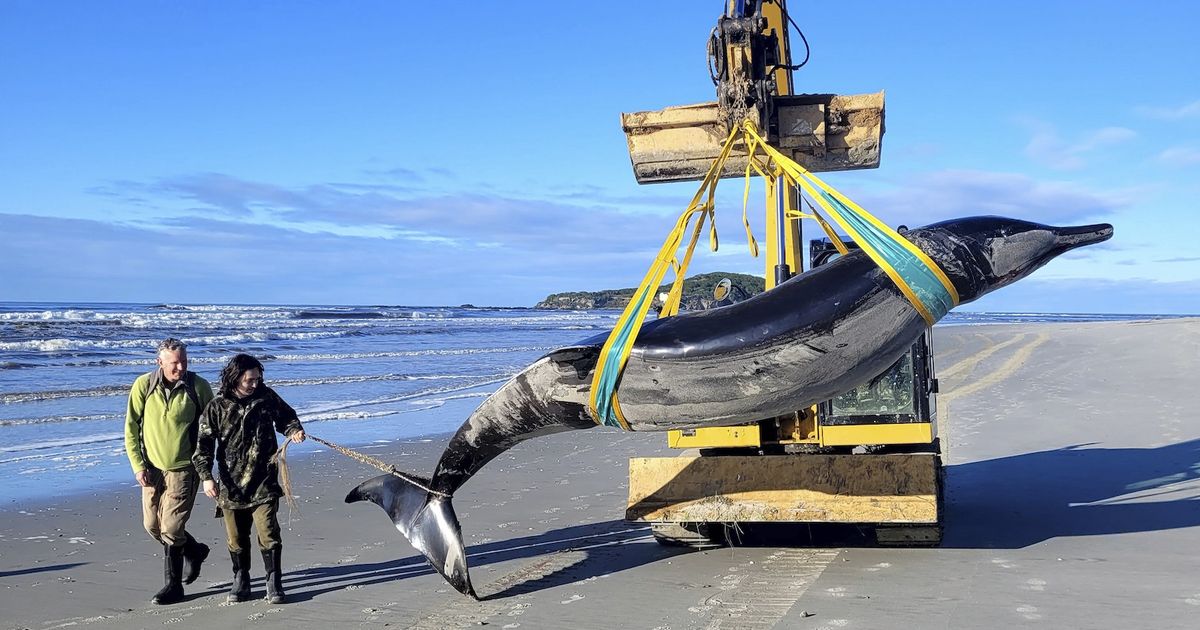WELLINGTON, New Zealand – The Bahamonde’s beaked whale It is the rarest in the world, and there has never been a documented sighting of it alive. No one knows how many there are, what they eat or even where they live in the vast expanse of the South Pacific Ocean. But scientists in New Zealand think they may have got a clue.
The country’s conservation agency said Monday that a creature that washed up on a South Island beach this month was believed to be a Bahamonde beaked whale, also called Travers’ beaked whale. The five-metre-long animal was identified by its colours and the shape of its skull, beak and teeth after it washed up on the Otago beach.
“We know very little, almost nothing” about the species, Hannah Hendriks, a marine technical adviser for the Department of Conservation, told The Associated Press. “This is going to lead to incredible science and first-hand information.”
If the whale is confirmed to be the elusive Bahamonde beaked whale, it would be the first specimen found in a state that allows scientists to dissect it and map out the whale’s relationship to other specimens found, as well as discover what it eats and perhaps some clues as to where it lives.
Only six other whales of that species have been documented, and those found intact off New Zealand’s North Island were buried before DNA testing could verify their identification, Hendriks said, thwarting the possibility of studying them.
The stranded whale was quickly moved to a refrigerated storage facility and researchers will work with indigenous Mori Iwi communities to plan its study, the conservation agency said.
New Zealand’s indigenous people regard whales as taonga, a sacred treasure, of cultural significance. In April, Pacific indigenous leaders signed a treaty recognizing whales as “legal persons,” although that declaration is not reflected in the laws of the participating nations.
Nothing is currently known about the whales’ habitat. The creatures dive very deep to find food and likely come up so rarely that it’s impossible to pinpoint their location more precisely than the South Pacific Ocean, home to some of the deepest ocean trenches on the planet, Hendriks said.
“It’s very difficult to research marine mammals if you don’t see them in the sea,” he said. “It’s like a needle in a haystack. You don’t know where to look.”
The conservation agency said genetic testing to confirm the whale’s identification could take months.
It took “many years and a monumental effort by researchers and local people” to identify these “incredibly cryptic” mammals, said Kirsten Young, a professor at the University of Exeter who has studied Bahamonde beaked whales, in comments sent by email.
The new discovery “makes me wonder, how many are there in the deep ocean and how do they live?” Young said.
The first documented bones of a Bahamonde beaked whale were found in 1872. Another discovery was made on a smaller island in the 1950s, and bones of a third turned up on Robinson Crusoe Island in Chile in 1986. DNA analysis in 2002 showed that all three specimens belonged to the same species, and that it was a distinct variety from other beaked whales.
Researchers studying the mammal were unable to confirm whether the species had become extinct. Then, in 2010, two entire specimens, both dead, washed up on a beach in New Zealand. Initially mistaken for one of the 13 other types of beaked whales common in New Zealand, samples were later found to be the enigmatic species after burial.
New Zealand is a frequent site of whale strandings, with more than 5,000 incidents recorded since 1840, according to the Department of Conservation.
Source: AP

